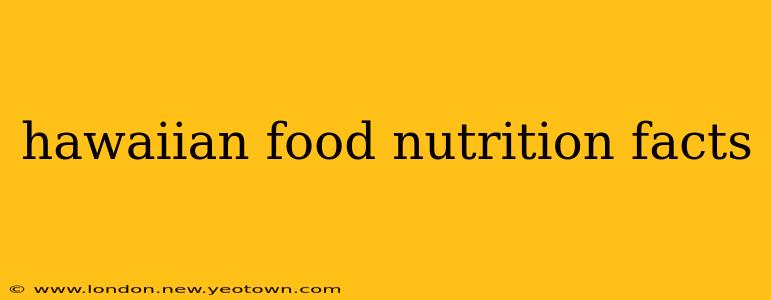Imagine yourself on a sun-drenched Hawaiian beach, the scent of plumeria in the air, and the taste of a succulent kalua pig melting in your mouth. Hawaiian cuisine is more than just a delicious escape; it's a vibrant reflection of the islands' culture and a surprisingly diverse source of nutrition. But what exactly is the nutritional profile of these tropical treats? Let's explore the nutritional facts behind some of Hawaii's most beloved dishes.
What are the main nutritional components of Hawaiian food?
Hawaiian cuisine boasts a delightful mix of nutritional powerhouses. Fresh seafood, such as tuna and mahi-mahi, provides lean protein and omega-3 fatty acids, crucial for heart health and brain function. The abundance of tropical fruits, like mangoes, pineapples, and papayas, delivers vitamins A and C, antioxidants, and natural sugars for energy. Then there are the starchy staples: poi, made from taro root, offers carbohydrates for sustained energy, and rice, a common accompaniment to many dishes, provides another source of carbohydrates. However, the nutritional profile varies significantly depending on the specific dish and its preparation. A plate of grilled fish with steamed rice and a side of fresh fruit will offer a very different nutritional profile than a luau featuring kalua pig, poi, and lau lau (meat wrapped in taro leaves).
What are some healthy Hawaiian dishes?
Many traditional Hawaiian dishes lean towards the healthy side, especially those featuring an abundance of fresh ingredients. Poke, a raw fish salad marinated in soy sauce, sesame oil, and seaweed, is packed with protein and healthy fats. Lomi salmon, a cured salmon salad, is another excellent source of protein and omega-3 fatty acids. Dishes featuring grilled or baked fish with steamed vegetables offer a well-balanced, nutritious meal. The key is to focus on dishes with minimal added sugars, saturated fats, and processed ingredients.
Are there any unhealthy aspects of Hawaiian food?
While Hawaiian cuisine boasts many healthy options, certain dishes can be higher in calories, fat, and sodium. Kalua pig, for example, is often prepared using a traditional method involving slow roasting in an underground oven (imu), which can result in a higher fat content. Poi, while providing carbohydrates, can be relatively high in calories. Many dishes also incorporate coconut milk, which is rich in healthy fats but also adds to the overall calorie count. Also, the addition of processed ingredients, like excessive amounts of soy sauce and sugar, can greatly affect the nutritional profile of a dish.
Is Hawaiian food good for weight loss?
Whether Hawaiian food is good for weight loss depends entirely on the choices made. Focusing on lean protein sources like fish, incorporating plenty of fruits and vegetables, and choosing healthier preparation methods (grilling, baking, steaming) can contribute to a weight-loss-friendly diet. However, indulging in higher-calorie dishes like kalua pig and rice in large portions, along with sweetened desserts, can easily hinder weight loss efforts. Moderation and mindful portion control are key.
What are some tips for eating healthy Hawaiian food?
To maximize the nutritional benefits of Hawaiian food, consider these tips:
- Choose lean protein sources: Opt for grilled fish or chicken over fatty meats.
- Load up on fruits and vegetables: Incorporate a variety of tropical fruits and vegetables into your meals.
- Go easy on the poi and rice: These are high in carbohydrates; enjoy them in moderation.
- Minimize added sugar and sodium: Be mindful of the amount of soy sauce, sugar, and other processed ingredients added to dishes.
- Choose healthier cooking methods: Grill, bake, or steam your food instead of frying.
- Practice portion control: Be mindful of how much you're eating.
By understanding the nutritional components of Hawaiian food and making informed choices, you can enjoy the vibrant flavors of the islands while maintaining a healthy and balanced diet. Remember, it’s about balance and mindful consumption—allowing yourself to savor the unique and delicious culinary offerings while prioritizing your overall well-being.

